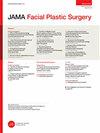Association Between Pain and Patient Satisfaction After Rhinoplasty.
Q1 Medicine
引用次数: 15
Abstract
Importance In light of the current opioid crisis, there exists a demonstrated need to balance adequate postrhinoplasty pain control with measured use of narcotics. If pain is inadequately controlled, patients may be unsatisfied with their elective surgical experience. Objectives To characterize the association between patient-reported pain outcomes, objective opioid use, and perception of surgical success. Design, Setting, and Participants A case series survey study was conducted from July 2018 to January 2019. Consecutive patients who underwent cosmetic and/or functional rhinoplasty by 2 facial plastic surgeons (D.A.S. and L.N.L.) at an academic medical center were surveyed 1 month after surgery. Main Outcomes and Measures The number of oxycodone tablets taken, patient-reported pain outcomes, number of narcotic prescription refills, and patient-reported functional and cosmetic outcomes were recorded. Perception of pain, surgical outcome, and oxycodone intake were also evaluated by sex. Demographic information and perception of surgical results were recorded. Statistical analysis was performed using STATA statistical software (version 12.0, STATA Corp). Spearman rank order correlation was used for ordinal, monotonic variables with P < .05 being considered statistically significant. Results Overall, 104 patients were surveyed; 6 were lost to follow-up. Of the participants included, 50 were women with a mean (SD) age of 38 (16.0) years and 48 were men with a mean (SD) age of 38 (16.7) years. Although patients were prescribed a range of 10 to 40 tablets of oxycodone, patients took a mean (SD) of 5.2 tablets (range, 0-23). There were no significant sex differences in perception of pain, perception of outcome, or narcotic use. Among patients undergoing purely functional rhinoplasty, a statistically significant negative association between perception of pain and perception of functional outcome (breathing improvement) was evident. Patients who experienced less pain than they expected had a greater perception of functional improvement (rs = -0.62, P = .001). In contrast, among patients who underwent rhinoplasty with cosmetic improvement, no association was found between pain and perception of surgical outcome (rs = 0.05, P = .64). Conclusions and Relevance To our knowledge, this is the first study to prospectively evaluate the association between opioid use, patient-reported pain, and perceived surgical success. These data may help guide preoperative counseling because patients who are interested purely in breathing improvement (without cosmetic change) may warrant additional pain-specific counseling to optimize patient satisfaction. Level of Evidence 3.鼻整形术后疼痛与患者满意度的关系。
鉴于当前的阿片类药物危机,有必要在鼻成形术后适当的疼痛控制与麻醉药物的适度使用之间取得平衡。如果疼痛控制不充分,患者可能不满意他们的择期手术经验。目的探讨患者报告的疼痛结局、客观阿片类药物使用和手术成功感知之间的关系。设计、环境和参与者2018年7月至2019年1月进行了一项案例系列调查研究。在一个学术医疗中心由2名面部整形外科医生(D.A.S.和L.N.L.)连续接受整形和/或功能性鼻整形的患者在手术后1个月进行调查。记录羟考酮片剂的服用次数、患者报告的疼痛结果、麻醉处方补剂次数以及患者报告的功能和美容结果。疼痛感觉、手术结果和羟考酮摄入量也按性别进行评估。记录人口统计学信息和对手术结果的感知。采用STATA统计软件(12.0版,STATA Corp)进行统计分析。对于P <的有序单调变量,采用Spearman秩序相关。0.05被认为具有统计学意义。结果共调查104例患者;6例失访。包括50名女性,平均(SD)年龄为38(16.0)岁,48名男性,平均(SD)年龄为38(16.7)岁。虽然患者的羟考酮处方范围为10 - 40片,但患者的平均(SD)为5.2片(范围为0-23)。在疼痛感知、结果感知或麻醉使用方面,没有显著的性别差异。在接受纯功能性鼻整形术的患者中,疼痛感知与功能性结果感知(呼吸改善)之间明显存在统计学上显著的负相关。疼痛程度低于预期的患者对功能改善的感觉更强(rs = -0.62, P = .001)。相比之下,在整容改善的鼻整形患者中,疼痛与手术结果感知之间没有关联(rs = 0.05, P = 0.64)。据我们所知,这是第一个前瞻性评估阿片类药物使用、患者报告的疼痛和感知手术成功之间关系的研究。这些数据可能有助于指导术前咨询,因为纯粹对呼吸改善(不改变外观)感兴趣的患者可能需要额外的针对疼痛的咨询,以优化患者满意度。证据水平
本文章由计算机程序翻译,如有差异,请以英文原文为准。
求助全文
约1分钟内获得全文
求助全文
来源期刊

JAMA facial plastic surgery
SURGERY-
CiteScore
4.10
自引率
0.00%
发文量
0
期刊介绍:
Facial Plastic Surgery & Aesthetic Medicine (Formerly, JAMA Facial Plastic Surgery) is a multispecialty journal with a key mission to provide physicians and providers with the most accurate and innovative information in the discipline of facial plastic (reconstructive and cosmetic) interventions.
 求助内容:
求助内容: 应助结果提醒方式:
应助结果提醒方式:


